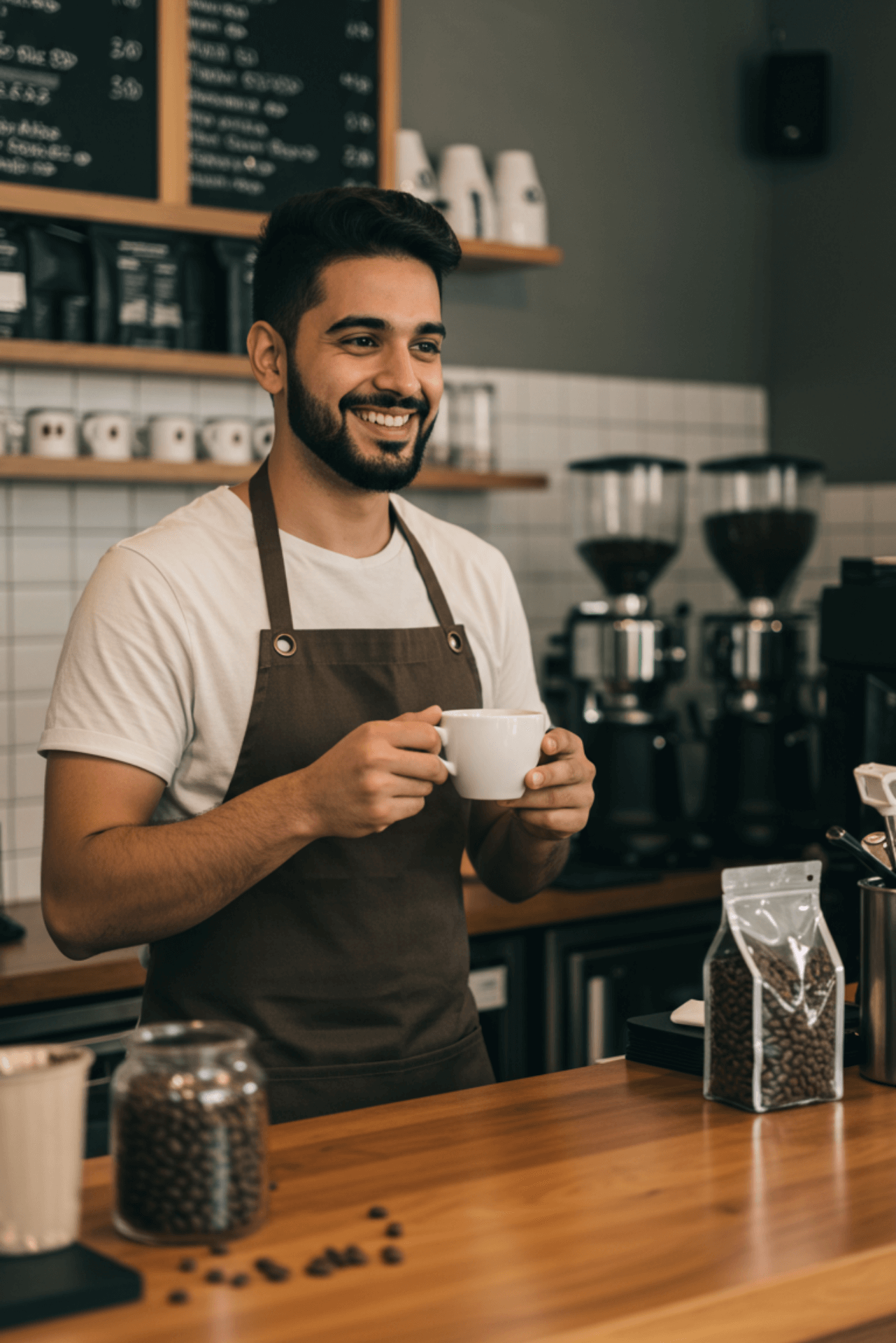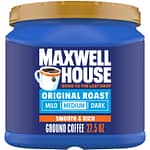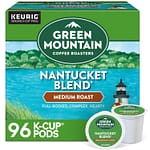Did you know a single cup of drip coffee has more caffeine than a 2-shot latte? That’s a surprising fact we’ll explore. Our team, including Elika Liftee and Kay Cheon with decades of experience, answers your coffee FAQs. They’ll clear up why light roast has more caffeine and how to balance freshness and flavor.
Every perfect cup comes from hard work: one coffee tree gives just one pound of beans, picked many times for ripeness. Specialty beans are always handpicked, not machine-harvested. We’ll debunk myths like “older coffee tastes better” (spoiler: flavor peaks in 28 days after roasting).
Key Takeaways
- A drip coffee’s caffeine content outshines a 2-shot latte.
- Specialty coffee tastes best within 4–28 days post-roast.
- Light roast beans retain more caffeine than dark roast.
- Handpicking ensures quality but requires over 4 harvests per tree.
- 83 Custom Coffee tests espresso shots hourly to guarantee quality.
Introduction
Curiosity is the key to better coffee. This guide answers your most pressing coffee questions, backed by barista advice from experts. Whether you’re a casual drinker or a home brewer, understanding the basics transforms your daily cup.
Why Coffee Questions Matter
“I always wondered why coffee is given a lot of attention. It’s just coffee, right? No, it’s much more than that.” – Nicholas Senyondo, head barista
Asking questions unlocks insights into bean origins, brewing techniques, and flavor profiles. Even small details like water temperature (195–205°F) or bean freshness matter. Every question brings you closer to perfecting your cup.
- Market growth shows rising demand for quality coffee.
- Questions drive better brewing practices.
- Expert barista advice turns curiosity into expertise.
Meet Your Barista Guides
Our team has over 20 years combined experience. Nicholas Senyondo, our head barista, leads a group passionate about sharing knowledge. We’ve answered thousands of coffee questions and developed pro tips like dosing (7g for single shots) or proper tamping. This guide compiles the best barista advice to help you brew like a pro.
Through this guide, you’ll discover how small changes—like using filtered water or storing beans properly—impact flavor. Every question asked here leads to better results.
Common Coffee Questions and Answers
Confused by coffee FAQs? We’ve got answers to the top coffee questions customers ask daily. Let’s break down the basics so you can order with confidence.
Cold Brew vs. Iced Coffee: What’s the Difference?
Nitro versions of both get a nitrogen infusion. This makes them creamy without added sugar.
“Iced coffee is brewed hot and then chilled… Cold brew is brewed with room temperature or cold water.” – Elika Liftee
Debunking Coffee Myths
- Myth: Cold brew has more caffeine. Truth: Caffeine depends on how much coffee you use, not the method.
- Myth: Cold brew is less acidic. Truth: Both have same acidity levels—cold brew just feels smoother at lower temps.
- Myth: Dark roasts have more caffeine. Truth: Light roasts retain more caffeine, as roasting reduces bean density.
Seasonal Coffee Questions
When’s the right time for iced coffee? Science says May in Arkansas when temps hit 70°F, but we say drink it whenever you want. Seasonal changes also affect flavor—summer calls for lighter roasts, winter for bold espresso-based drinks.
How to Choose the Right Coffee Beans
Choosing the right beans starts with knowing where your coffee comes from. Coffee origins shape flavor as much as roast levels do. Let’s break it down with barista advice to simplify your next purchase.
Understanding Coffee Origins
African beans often showcase bright acidity and floral notes, like jasmine or berries. Central American beans lean toward nutty or chocolatey profiles. Arabica beans make up 60–70% of global production, offering complex flavors, while Robusta’s higher caffeine (up to 2.7%) suits espresso blends. Look for elevation details—beans grown above 1,200 meters taste sweeter.
Decoding Roast Levels
- Light Roast: Reveals origin flavors (fruit, floral) but can taste acidic.
- Medium Roast: Balances origin notes with caramel sweetness.
- Dark Roast: Bold and smoky, masking origin traits. Best for cold brew or French press.
Light roasts work best with pour-over methods, while dark roasts shine in espresso-based drinks. Pair your roast with coffee brewing tips for maximum flavor.
Bean Selection Tips from Pros
“We start by cupping beans and testing brew methods to ensure consistency,” says barista Nicholas Senyondo. “Always check the roast date—fresh beans matter most.”
Seek single-origin beans for unique profiles or blends for balance. Store beans in airtight containers, away from light. Prioritize roasters who detail flavor notes (e.g., “citrusy” or “chocolatey”) and avoid vague terms like “premium.”
Opt for Fair Trade options to support ethical sourcing. And remember: dark roasts hide flaws, but light roasts highlight a bean’s true character. Your choice depends on your brew method and taste goals.
What's the Best Brewing Method?
Finding the right brew style is about personal taste, not trends. Our coffee brewing tips and barista advice help you understand how brewing methods affect flavor.
Comparing Popular Brewing Techniques
Each brewing method produces unique flavors. Here’s a comparison:
- Pour-over: Brews in 2.5-4 minutes. Uses a medium-fine grind, like table salt. It brings out floral or fruity notes. You need to pour steadily.
- French Press: Steeps for 4-5 minutes. Needs a coarse grind, similar to sea salt. It’s great for bold, full-bodied coffee.
- AeroPress: Brews in 1-2 minutes. Uses a medium grind. It makes clean, low-acidity coffee. It’s also compact for travel.
- Espresso: Extracts in 20-30 seconds. Requires an ultra-fine grind. It needs precise tamping for a rich crema.
“Manual pour-over lets you taste the coffee’s origin. I serve mine black at warm temperatures.” — Nicholas Senyondo, head barista
Match Methods to Coffee Types
Some combinations reveal hidden flavors:
- Ethiopian naturals: pour-over brings out berries and citrus.
- Colombian filter roasts: AeroPress or drip for balanced acidity.
- Espresso blends (Big Trouble, Hologram): espresso machines for dense crema.
- Cold brew: 16-24 hour steep. Mix with water 1:3 for perfect dilution.
Equipment Picks for Every Budget
Start with these tools:
- Hario V60 ($28): Starter pour-over kit with paper filters.
- Bodum French Press ($30): Durable glass carafe for classic immersion brew.
- Aeropress ($40): Portable for travel or office use.
- Bonavita Brewer ($190): Consistent drip brew for daily use.
- Gaggia Espresso ($449): Compact machine for home espresso.
Focus on technique and bean quality first. Great coffee starts with fresh, high-quality beans.
How to Froth Milk Like a Pro
Perfect milk froth turns regular coffee into a special treat. Our coffee brewing tips make it easy, whether you use an espresso machine or a French press. Let’s get to the basics.
Understanding Different Milk Types
Cow’s milk comes in different types:
- Whole milk: 5% fat makes creamy microfoam for latte art.
- Oat or almond blends: Look for barista editions with added fats for stable foam.
- Skim milk: Avoid for espresso drinks—its low fat leads to weak foam.
Frothing Technique Basics
Follow these steps for consistent results:
- Pour cold milk into a pitcher (1/3 to 1/2 full).
- Submerge the steam wand just below the surface. Listen for a soft “paper-tear” sound.
- Heat milk to 140–155°F. Stop when touching the pitcher’s side feels too hot to touch.
For manual methods, pump a French press up and down until milk doubles in volume.
Common Milk Frothing Mistakes
Avoid these pitfalls:
- Overheating: Milk over 158°F burns flavors.
- Incorrect wand positioning: Too deep kills foam; too shallow causes loud noises.
- Using old milk: Fresh dairy or plant-based milk textures better.
Remember, practice builds muscle memory. Mastering this espresso guide step makes every cappuccino and latte better!
The Secret to a Perfect Espresso Shot
In this section of our espresso guide, we explore the science behind the perfect shot. Barista advice focuses on three key areas: consistency, precision, and practice. Let’s break down the factors that turn coffee into art.
Espresso Fundamentals
Begin with the basics. Use the right amount of coffee: single baskets need 7–10g, doubles 16–18g, and triples 20–22g. Grind the beans to a medium-fine texture. Tamp them evenly with 20–30 pounds of pressure, like placing a book, not a brick.
“Our go-to ratio is 1:1.5—20g coffee to 30g liquid. Time should hit 25–30 seconds. Fresh beans and clean equipment are non-negotiables.”
Dialing In Your Espresso
- Shot timing: Under 25 seconds? Grind finer. Over 30? Coarser.
- Consistency check: Use scales for dose and yield. Grams matter—volume measurements lie.
- Temperature tricks: Keep your machine preheated. Cold brew heads drag out extraction.
Troubleshooting Common Espresso Problems
Sour shots? Overly bitter? Barista advice offers solutions:
- Sour: Shot pulled too fast. Adjust grind finer or check tamping.
- Bitter: Over-extraction from slow pours. Loosen grind or check machine pressure.
- Channeling: Uneven grinds let water rush through. Check your grinder’s consistency.
Clean daily: residue buildup ruins flavor. Purge your grinder daily to remove old grounds.
Remember, practice builds muscle memory. Experiment with ratios and grind settings weekly. Every machine behaves differently—your perfect shot is a fingerprint, not a formula.
Tips for Making Coffee at Home
Turn your kitchen into a café with these coffee brewing tips and coffee FAQs. Start with the right tools and mindset.
Creating Your Home Coffee Bar
Start with basics like a Bodum French Press ($30) or an Aeropress ($40). Add a Baratza Encore ESP grinder for even grinds. For a budget, a Bonavita 8-cup brewer is $190, and the Toddy Cold Brew System starts at $49. A kitchen scale is key for the right coffee-to-water ratio.
Morning Routine Optimization
- Pre-grind beans and portion them in airtight containers.
- Set up your grinder and scale the night before.
- Use filtered water; hard water can dull flavors.
Keep brewing temps right: 194°F for French press, 25 seconds for espresso. Need tips? Look up coffee FAQs online.
Beyond the Basics: Creative Coffee Ideas
“I’ll whip up an iced coffee as a pour-over every once in a while… or a Shakerato with honey syrup.” – Elika Liftee
Try Elika’s Shakerato: mix espresso, syrup, and ice for a cool drink. Cold brew? Steep for 16–24 hours, then dilute 3:1 with water. Get creative with mocktails like lavender-infused cold brew or spiced chai lattes. Clean equipment is key for fresh flavors—wipe crema daily and deep-clean weekly.
Conclusion: Mastering Your Coffee Knowledge
Learning about coffee isn’t about knowing everything. It’s about asking the right questions and staying curious. We’ve covered barista advice and coffee questions to guide you. Every sip and every cup is a chance to learn more.
The Continuous Coffee Journey
Every question you ask helps you understand coffee better. Even experienced baristas keep learning every day. Visit local cafes, talk to baristas, and try new techniques. Coffee is a journey, and each question brings you closer to the perfect cup.
Developing Your Personal Coffee Style
Your coffee taste is unique. Try different roasts, brewing methods, and beans. Experiment with Arabica and Robusta to find what you like. Share your findings with baristas for more advice. It’s all about what makes you happy.
Nicholas Senyondo, a head barista, said, “Great coffee doesn’t need to score 90+. It’s the kind that makes you reminisce about sweet memories and keeps you coming back for more.” So, keep exploring and let your taste evolve. Your next favorite brew is just a question away.
FAQ
What is the difference between cold brew, iced coffee, and nitro cold brew?
Cold brew is made by steeping coffee in cold water for a long time. This makes it smooth and less acidic. Iced coffee is brewed hot and then cooled, giving it a brighter taste. Nitro cold brew is cold brew with nitrogen gas, making it creamy and foamy.
Does cold brew coffee have more caffeine than regular coffee?
It depends on the brewing ratio. Cold brew is often more concentrated. But if diluted right, it might not have more caffeine than regular coffee.
When does iced coffee season start?
Iced coffee season is whenever you want it! Enjoy it anytime you feel like it, no matter the season.
How do I choose the right coffee beans for my taste?
Think about what you like. If you like fruity notes, try Ethiopian beans. For chocolatey flavors, choose Colombian beans. Try different origins and roast levels to find your favorite.
What’s the difference between light, medium, and dark roast coffees?
Light roasts are acidic with fruity flavors. Medium roasts are balanced with sweetness. Dark roasts are bolder, richer, with chocolate or caramel notes.
What brewing method is the best for me?
There’s no one best method! Each method brings out different flavors. Try pour-over for a bright cup or French press for something heavier. Experiment to find what you like best!
How can I froth milk at home?
Use a steam wand, French press, or handheld frother. Make sure your milk is fresh and cold. Aim for a temperature of about 150°F, not boiling.
What’s the key to a great espresso shot?
A great espresso balances sweetness, acidity, and bitterness. Focus on grind size, dosing, and brew time. Experiment to find the perfect balance for you.
What are some tips for setting up my home coffee bar?
Keep your essentials organized and invest in quality tools like a good grinder. Make sure your workspace is clean. Try different brewing methods and keep beans fresh in an airtight container!
How can I enhance my coffee experience at home?
Try making signature drinks or coffee mocktails. Explore seasonal flavors. Personalize your coffee routine when you can. The journey is as enjoyable as the final cup!










